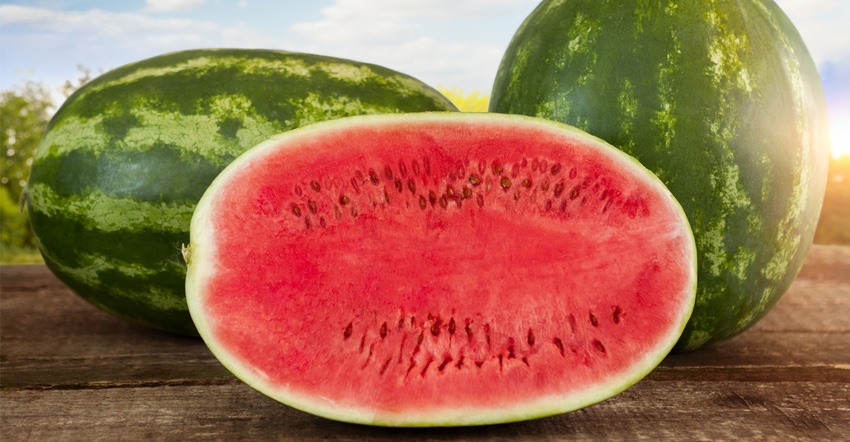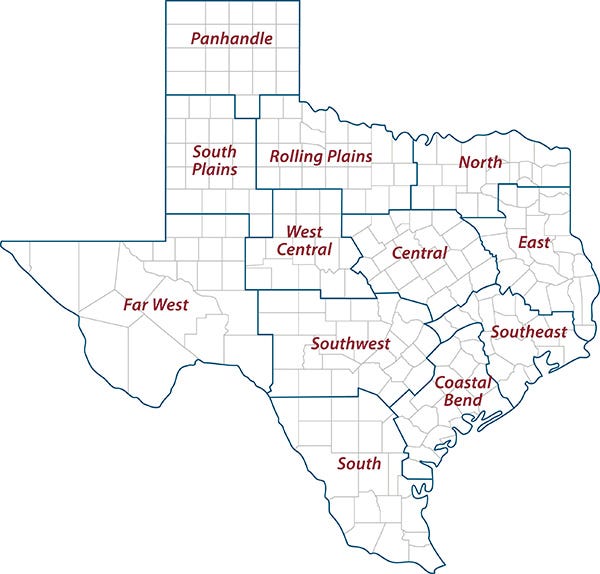
Winter Storm Uri and subsequent cool, wet weather have made the 2021 growing season tough on Texas watermelons, but decent prices are helping producers, according to Texas A&M AgriLife Extension Service experts.
Watermelons in South Texas got a late start due to the winter storm in February, said Juan Anciso, AgriLife Extension horticulturist, Weslaco. Many fields under hoop tunnels experienced delays and required partial replanting due to the cold weather.
Harvest typically begins April 15 in hoop tunnels and typically peaks with traditional field-grown watermelons by mid-May for Memorial Day weekend, Anciso said.
Rain has also presented harvest delays and challenges, he said. Fields were left muddy by 8-10 inches of rainfall, which has made harvest difficult. Trucks and trailers were stuck in fields and crews faced tough conditions, including heavy mosquito infestations. Additionally, hiring workers to harvest has been more difficult than in past seasons.
Anciso said the freeze helped reduce white fly populations, which in turn reduced the transmission of viral diseases. The wet weather caused concerns about fungal diseases, but farmers have been vigilant about spray applications to keep disease infestations down.
The rains, however, have not affected melon quality, Anciso said. Brix counts, the measurement for sweetness have remained at 10-plus. Brix counts of 10 are standard sweetness, while 11 and above indicate exceptionally sweet. Watermelon color both inside and outside were also meeting market standards.
Heavy rains at the wrong time can waterlog melons, which thins their Brix count and the redness of the fruit and causes their outer layer to turn white, Anciso said.
“This year was a challenge early with the freeze and late because of the rain,” he said. “But it looks like quality is still good and prices were pretty good.”
Watermelons: This year vs. last year
Last year, Florida had difficultly with their crop at harvest because COVID-19 impacted their seasonal harvesting crews, Anciso said. The subsequent shortage of melons coming out of Florida made demand and prices for Texas watermelons climb.
Texas watermelon prices peaked at between 33-35 cents per pound at wholesale. This year, Florida watermelons have normalized demand, and Texas watermelons were fetching 20-22 cents per pound at wholesale, Anciso said.
Prices are still markedly better than they were in 2019 when watermelons were at 14-16 cents per pound wholesale and producers were losing $1,000 per acre planted on average, he said.
“The prices are still good, they’re just not as high as they were getting, and all the difficulties between the freeze and pulling out equipment and having trouble finding harvesting crews make margins a little thinner,” he said. “It’s been quite the headache to get them harvested this year, but given how difficult it’s been, hopefully producers can turn a profit.”
Winter Garden watermelons
Larry Stein, AgriLife Extension horticulturist, Uvalde, said growing conditions have been similar to those in South Texas and have created similar delays.
The cooler, rainy weather since late April could mean delays in watermelon fields typically scheduled to meet the Fourth of July market demand window. Vines in the Winter Garden region are starting to bloom, and beehives are onsite to pollinate.
Female watermelon flowers typically need 15 visits by bees to deliver enough pollen for proper fruit set, Stein said. The process from bloom to vine-ripe fruit being ready for harvest typically takes 30 days, which means the timing could be tighter than producers prefer.
“It will be good for producers who sell from a fruit stand or let people pick their own,” he said. “But producers typically want them coming off the vine a week to 10 days before the holiday weekend to meet the wholesale orders and get them to grocers in time. But plants are about seven to 10 days behind schedule right now.”
AgriLife Extension district reporters compiled the following summaries:

CENTRAL
Soil conditions were saturated from repeated rains. Wheat harvest should be underway but was severely delayed by rain. Wheat plants were starting to lodge in fields. There were some reports of grain sprouting in heads. Corn was doing very well, but we need dry weather as corn enters the pollination stage. Producers were concerned about poor grain fill without proper pollination. Cotton was struggling due to wet growing conditions. Oats needed to be harvested. Hay fields should have been cut a month ago, but conditions continue to be too wet. Many producers missed their first hay cutting and should be near a second cutting. Livestock were doing well. Cooler and wet weather was in the forecast for the next 10 days.
ROLLING PLAINS
Rain throughout the week put most agriculture activities on hold in some areas, but some areas received no rain. Palo Pinto County reported 4 inches of rainfall. Wheat conditions continued to decline due to excess rainfall causing head sprouting and smut/black heads. Wheat was being grazed out by some producers. Rangelands responded very well, and grasses were growing rapidly. Stock tanks filled back up in some areas, but more runoff was needed in other areas before summer. Cotton planting will begin when conditions dry enough.
COASTAL BEND
Wet conditions prevailed. Some crops, especially cotton in low lying areas, were suffering from too much water. Corn standing in saturated soils were showing signs of root stress and dropping lower leaves. Denitrification was expected in corn. Southern rust, common rust and northern leaf blight was reported in corn fields. Aerial fungicide applications on corn were underway. Rice was doing well. Soybeans were tolerating the wet field conditions. Wheat was ready, but harvest was delayed due to wet fields. Wheat head shattering was expected under present weather conditions. Weeds were becoming an issue in fields. Rangeland and pasture conditions were good with some standing water. Many producers were unable to harvest hay due to wet conditions. Flies and mosquitoes were a problem, and livestock were bunching up in pasture corners trying to get away from flying pests. Livestock tanks were full.
EAST
The rain continued to fall across the district. More rain was forecasted. The district was thoroughly saturated with water standing in hay fields. Producers were unable to cut or bale hay in most counties. Cherokee County reported producers had lost the first cutting of ryegrass and clover because it died out before it could be baled. Pasture and rangeland conditions were fair to excellent. Subsoil and topsoil conditions were surplus. Tomatoes were wilting and yellowing due to too much rainfall. Ponds, creeks and lakes were all full or overflowing. Cattle prices were low. Livestock were doing fair to good. Fly populations remained high. Feral hog activity continued to be a problem.
SOUTH PLAINS
Counties received 1-7 inches of rain over the past week. Rains were great for pasture grasses and livestock tanks but were making it difficult for producers to plant cotton and cut hay. Cattle were in good condition.
PANHANDLE
Timely rains improved soil profile moisture and benefited maturity and yield of winter small grain crops as well as emergence of recently planted warm-season crops. Northern and central areas reported adequate to surplus soil moisture, while southern areas reported short to adequate soil moisture levels. Pasture and rangeland conditions were poor to excellent around the district. Winter wheat conditions were poor to good. Corn and sorghum fields were in good to excellent condition. Soybeans were in excellent condition, and oats were in fair to good condition.
NORTH
Topsoil moisture ranged from adequate to surplus. Continual rains saturated soils with an additional 1-5 inches this week. Pastures were saturated, and ponds were full. Winter wheat was turning color, and producers needed some dry days to let wheat fields dry for harvest. Corn planted early was doing well, but later-planted corn and sorghum fields with wet conditions were a concern. Summer grasses were lagging behind normal growth due to excessive rain and cool night temperatures. Some producers were concerned that livestock were standing in wet pastures continuously with no place for hooves to dry. Insect control was becoming more challenging on livestock. Spring-born calves were doing well.
FAR WEST
No report.
WEST CENTRAL
Most areas received on and off rains for most of the week. Some early cotton was planted. Hay producers began cutting drier fields late in the week. Haygrazer was in really good shape due to all the moisture. Pastures and rangeland had improved over the last few weeks and weed management continued. Cattle market quoted steady last week on stockers and feeders. Most livestock were in good condition.
SOUTHEAST
No report.
SOUTHWEST
Pasture and rangeland conditions were steadily improving due to frequent moisture and seasonal temperatures. Wheat harvest was delayed in some areas due to wet weather. Fieldwork slowed. Corn, cotton and sorghum crops were doing well. Wilson County reported sugarcane aphids and fall armyworms were present after recent rains. Livestock conditions were fair to good and improving. Supplemental feeding of livestock declined. Sheep and goat prices remained steady and high. Caldwell County reported cattle prices were fair.
SOUTH
Scattered showers delivered trace amounts up to 4.5 inches across the district. Soil moisture levels were short to surplus, but most areas improved significantly over the past few weeks. Nearly all crop fields responded well to the rain. Cotton was drowned out or waterlogged in some locations and progressing well with good moisture in most areas. Corn was silking in some areas and in good shape overall. Sweet corn harvest was underway in some areas. Pastures and rangelands were in good condition and improving, but some overgrazed pastures were still in bad condition. Hay production occurred between rains, but some producers were still waiting for their first cutting. Strawberries and cool-season vegetables were still producing for some farmers due to cooler conditions. Wheat and oat harvests were almost complete. Peanut planting continued with some delays due to rain. Irrigated crops like watermelons, cantaloupes and Coastal Bermuda grass looked good. There were some delays to watermelon, cantaloupe and other harvests due to wet conditions. Cattle were doing well with steady prices in all classes at market, and sales and deeper culling reduced drastically. Producers in drier areas were still selling calves, culling and providing supplemental feed for livestock and wildlife. Wildlife benefitted from the rains and new growth as well. Food plots of sunflowers and sorghum improved and progressed following rains but were not seeding out yet. Feed prices continued to rise. Sesame and soybean fields also improved.
Source: is AgriLife TODAY, which is solely responsible for the information provided and is wholly owned by the source. Informa Business Media and all its subsidiaries are not responsible for any of the content contained in this information asset.
Read more about:
WatermelonAbout the Author(s)
You May Also Like




